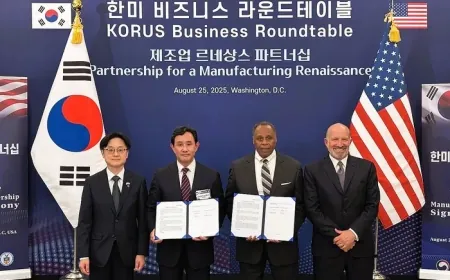Apple Global Manufacturing Strategy Faces Fresh Pressure from U.S. Tariffs
Apple is dealing with a $900 million tariff blow and possible new import taxes despite surging iPhone sales. With factories moving to India and Vietnam, risks are rising across its global supply chain.

Apple delivered stronger-than-expected iPhone sales in its latest quarterly results, reporting $95.4 billion in total revenue, with $26.6 billion from services and the rest from hardware. Despite the positive numbers, the company’s stock declined by 4%, largely due to growing concerns over how U.S. trade policies are affecting its global supply chain.
The company confirmed it is facing a $900 million hit in the current quarter due to tariffs, primarily related to Chinese imports. While smartphones and computers were technically exempted from these tariffs under current policies, Apple has had to adjust by moving a significant portion of iPhone production from China to India — a costly and logistically challenging shift.
Tariff Burden Hits Apple Harder Than Other Tech Companies
What sets Apple apart is its dependence on hardware for the majority of its revenue. Unlike Meta, Google, or Microsoft — which generate significant income through advertising, software, or cloud services — Apple’s core business relies heavily on physical products built overseas.
This structural difference makes the company far more exposed to import duties, particularly when tariffs are imposed or adjusted without much notice. Even minor policy changes can ripple across Apple’s operations and impact its quarterly earnings.
In contrast, companies like Google have said it’s still too early to determine any serious tariff effects, while Amazon has only slightly adjusted its operating income projections. Apple doesn’t have the same flexibility, making it a case study in how global trade policies directly affect companies with international manufacturing pipelines.
Manufacturing Moves to India and Vietnam Aren’t a Long-Term Fix
Apple’s shift to manufacturing iPhones in India and other products in Vietnam was a strategic response to U.S.-China tensions. However, while these countries currently benefit from temporary tariff pauses, they’re not immune to future trade actions. The U.S. is still in talks with both governments over broader trade terms, and duties could be reintroduced.
According to analysts, the potential for tariffs on India and Vietnam is a lingering threat that limits Apple’s ability to predict costs or scale manufacturing smoothly. This creates ongoing uncertainty for investors and operational headaches for the company’s supply chain planners.
Jefferies analyst Edison Lee noted that the current revenue projections for the June quarter assume no new tariffs on India or Vietnam and a 20% cap on Chinese tariffs. If those assumptions fail, profit margins could be squeezed further.
Possible Tariffs on Semiconductors Could Deepen the Impact
Beyond manufacturing locations, another concern is the Trump administration’s Section 232 investigation, which could lead to tariffs on semiconductors — a key component in Apple devices. If new duties are added on these chips, Apple may have to pay more for essential parts used in iPhones, Macs, and Apple Watches.
A rise in semiconductor costs would leave Apple with two options: absorb the costs and reduce profit margins, or raise retail prices — which could hurt demand. Jefferies estimates show that for every 1% increase in global tariffs, Apple’s pre-tax profit could fall by 1.5% in the next fiscal year, assuming prices stay the same.
This pressure could weigh heavily on Apple’s pricing strategy, especially in a market where consumer spending is already under pressure due to inflation and economic uncertainty in several regions.
Concerns About iPhone Sales Heading Into the June Quarter
Apple didn’t provide a detailed breakdown of product-specific revenue guidance, which some analysts view as a red flag. UBS analyst David Vogt said the forecast of “low to mid-single-digit growth” for the June quarter fell short of expectations and might suggest weakening demand for iPhones — particularly if higher costs from tariffs force Apple to limit production or delay launches.
The lack of clarity has led some market watchers to revise their expectations for Apple’s year-end performance. While services revenue remains a bright spot, any dip in iPhone or Mac sales could significantly impact the company’s bottom line.
Key Takeaways:
-
$900 million in projected tariff costs this quarter signals how directly policy decisions can impact corporate earnings.
-
Apple’s reliance on overseas production for most of its hardware means it remains more sensitive to global trade rules than its peers.
-
Strategic shifts to India and Vietnam may offer only short-term relief if trade deals fail to materialize.
-
Semiconductor tariffs — still under review — could raise hardware costs further.
-
iPhone sales, the company’s largest revenue driver, are facing new headwinds heading into mid-2025.
Apple’s attempt to move production outside China hasn’t offered much protection. Even as it expands manufacturing in India and Vietnam, those regions are now facing trade tensions of their own with the U.S. This shows how hard it is for global brands to avoid being caught in the middle of policy changes — especially when new tariffs or investigations can surface with little warning. For Apple, the question isn’t just where to manufacture, but how quickly it can adapt to each new round of trade uncertainty.
Also Read: China Removes Tariffs on Some U.S. Goods, But Denies Trump’s Trade Talks Claims





























































